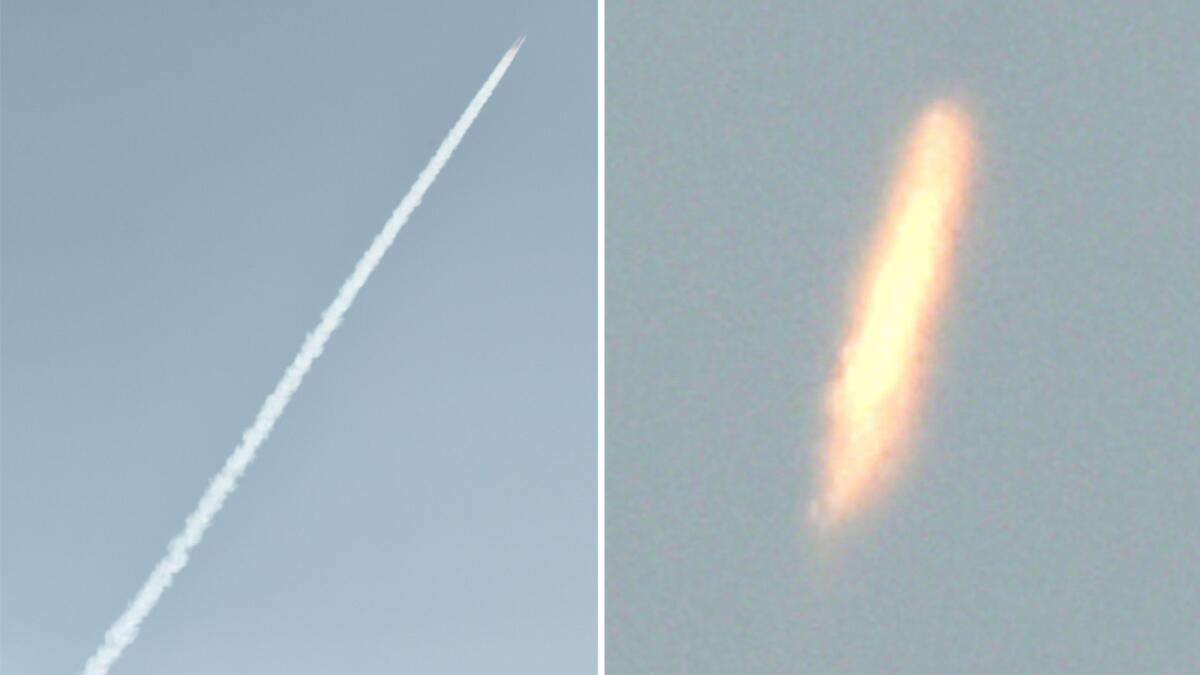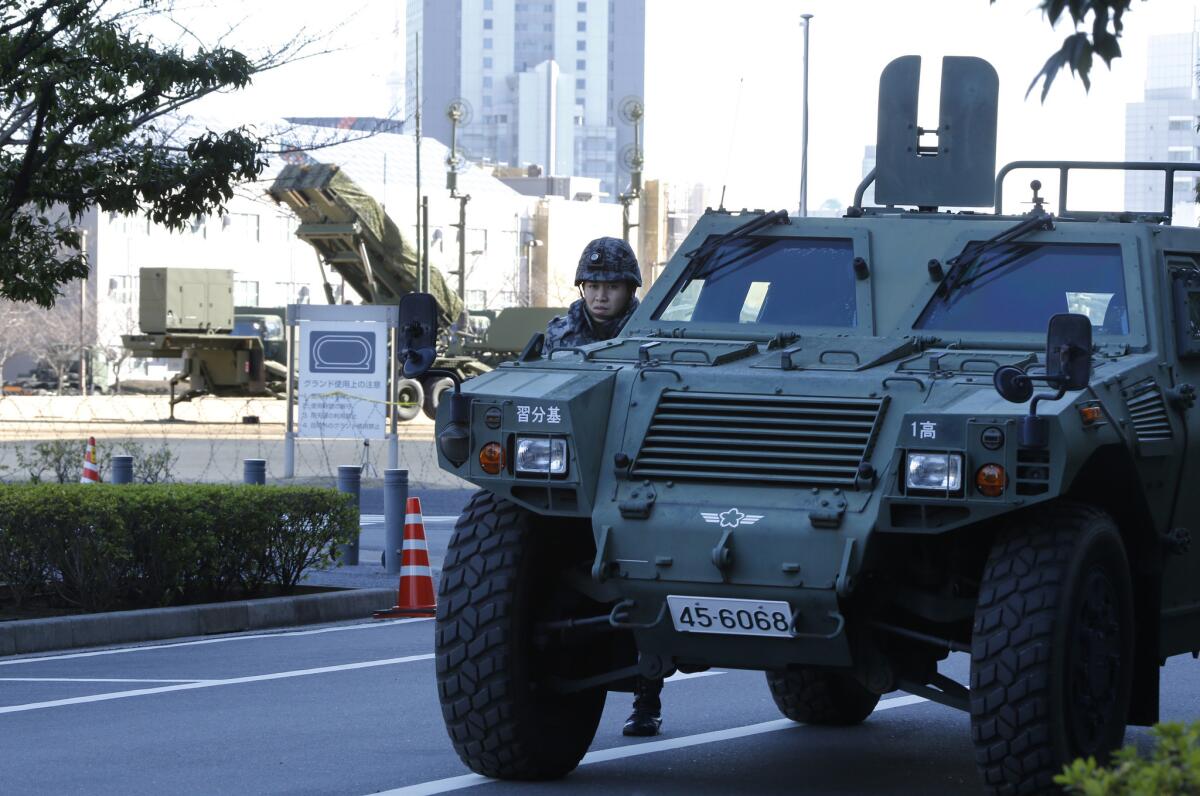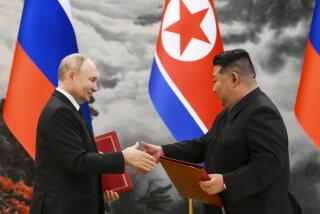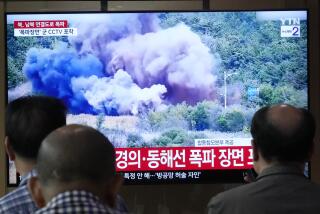North Korea says it has put a satellite into orbit with rocket launch

An unidentified object is photographed in the sky from Dandong, China, Sunday, Feb. 7, 2016.
- Share via
Reporting from SEOUL, South Korea — North Korea on Sunday defied international warnings and launched a long-range rocket that the United Nations and others call a cover for a banned test of technology for a missile that could strike the U.S. mainland.
The rocket was fired from North Korea’s west coast and its path was tracked separately by the United States, Japan and South Korea; no damage from debris was reported. At an emergency national security council meeting in Seoul, the country’s president called the firing an “intolerable provocation.”
North Korea, which calls its launches part of a peaceful space program, trumpeted the beauty of the launch’s “fascinating vapor” as the rocket cut through the clear blue sky and said it had successfully put a new Earth observation satellite, the Kwangmyongsong 4, or Shining Star 4, into orbit less than 10 minutes after liftoff. It vowed more such launches. A U.S. official said it might take days to assess whether the launch was a success.
The firing came about two hours after an eight-day launch window opened Sunday morning. It follows North Korea’s widely disputed claim last month to have tested a hydrogen bomb. Washington and its allies will consider it a further provocation and push for more tough sanctions. The United States and Japan quickly requested an emergency meeting of the U.N. Security Council on Sunday morning, saying Pyongyang violated a council ban on ballistic missile launches.
North Korean rocket and nuclear tests are seen as crucial steps toward the North’s ultimate goal of a nuclear armed long-range missile arsenal. North Korea under leader Kim Jong Un has pledged to bolster its nuclear arsenal unless Washington scraps what Pyongyang calls a hostile policy meant to collapse Kim’s government.
North Korea’s National Aerospace Development Administration, in typical propaganda-laden language, said Sunday that ruling Workers’ Party policies were responsible for the rocket’s success.
The statement praised “the fascinating vapor of Juche satellite trailing in the clear and blue sky in spring of February on the threshold of the Day of the Shining Star.” Juche is a North Korean philosophy focusing on self-reliance; the Day of the Shining Star refers to the Feb. 16 birthday of former dictator Kim Jong Il. North Korea has previously staged rocket launches to mark important anniversaries.
Defense Ministry spokesman Moon Sang Gyun said a South Korean Aegis-equipped destroyer detected the North Korean launch at 9:31 a.m. The rocket’s first stage fell off North Korea’s west coast at 9:32 a.m. and the rocket disappeared from South Korean radars at 9:36 a.m. off the southwestern coast. There was no reported damage in South Korea.
The South Korean government couldn’t immediately confirm reports by Yonhap news agency and YTN TV that the rocket might have failed.
The U.S. Strategic Command issued a statement saying it detected and tracked a missile launched on a southern trajectory but it did not pose a threat to the United States or its allies.

A member of the Japan Self-Defense Forces stands near a PAC-3 Patriot missile unit deployed for North Korea’s rocket launch at Defense Ministry in Tokyo, Sunday, Feb. 7, 2016.
Japan’s NHK broadcaster showed footage of an object visible in the skies from the southern island of Okinawa that was believed to be the rocket. Japanese chief Cabinet spokesman Yoshihide Suga told reporters that no debris fell on Japanese territory.
The global condemnation began almost immediately.
South Korean President Park Geun-hye said the launch was an “intolerable provocation.” She said the North’s efforts to advance its missile capabilities were “all about maintaining the regime” in Pyongyang and criticized the North Korean leadership for ignoring the hardships of ordinary North Koreans.
Japanese Prime Minister Shinzo Abe said: “We will take action to totally protect the safety and well-being of our people.”
U.S. National Security Adviser Susan Rice said in a statement that “North Korea’s missile and nuclear weapons programs represent serious threats to our interests — including the security of some of our closest allies — and undermine peace and security in the broader region.”
Kim Jong Un has overseen two of the North’s four nuclear tests and three long-range rocket tests since taking over after the death of his father, dictator Kim Jong Il, in late 2011. North Korea says its rocket launches are satellite missions, but the U.S., South Korea and others say they are a covert test of ballistic missile technology. The U.N. Security Council prohibits North Korea from nuclear and ballistic missile activity. Experts say that ballistic missiles and rockets in satellite launches share similar bodies, engines and other technology.
The Jan. 6 nuclear test has led to another push in the U.N. to tighten sanctions. North Korea in 2013 also did a nuclear test and then unnerved the international community by orchestrating an escalating campaign of bombast, including threats to fire nuclear missiles at the U.S. and Seoul.
The Korean border is the world’s most heavily armed and the rivals’ navies occasionally trade gunfire near a disputed boundary in the Yellow Sea.
North Korea has spent decades trying to develop operational nuclear weapons.
North Korea has said that plutonium and highly enriched uranium facilities at its main Nyongbyon nuclear complex are in operation. The North is thought to have a small arsenal of crude atomic bombs and an impressive array of short- and medium-range missiles. But it has yet to demonstrate that it can produce nuclear bombs small enough to place on a missile, or missiles that can reliably deliver its bombs to faraway targets.
After several failures testing a multistage, long-range rocket, it put its first satellite into space with a long-range rocket launched in December 2012.
The North’s recent activity comes amid a long-standing diplomatic stalemate. Six-nation negotiations on dismantling North Korea’s nuclear program in exchange for aid fell apart in early 2009.
Under Kim Jong Un, a February 2012 deal for the United States to provide 240,000 metric tons of food aid in exchange for a freeze in nuclear and missile activities collapsed after a rocket launch by the North that April.
MORE FROM WORLD
More than 150 people missing after Taiwan earthquake
In Brazil, Carnival-goers won’t let Zika or economic woes ruin the party
Vatican critic says only Pope Francis can dismiss him from sex abuse panel
More to Read
Sign up for Essential California
The most important California stories and recommendations in your inbox every morning.
You may occasionally receive promotional content from the Los Angeles Times.










